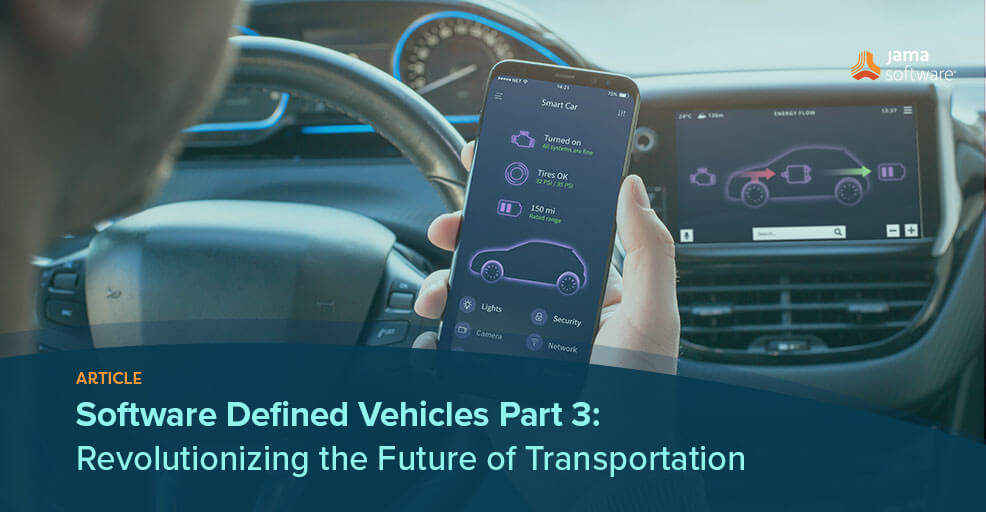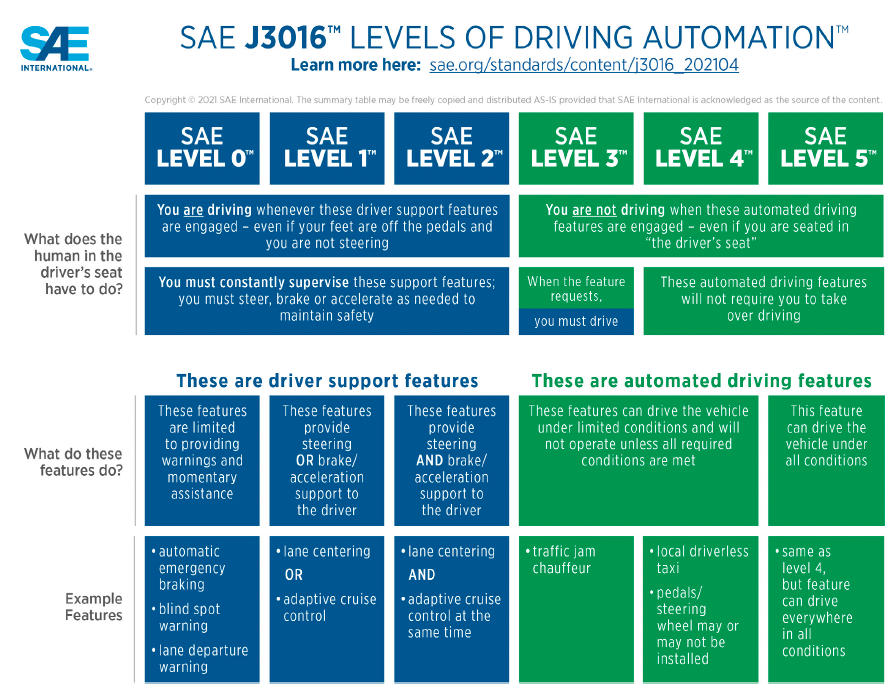
In part 3 of this three-part blog series, we will overview our whitepaper, “Software Defined Vehicles: Revolutionizing the Future of Transportation” Download the entire thing HERE and click here for part 1 and here for part 2.
Software Defined Vehicles Part 3: Revolutionizing the Future of Transportation
Future Trends and Considerations in Software Defined Vehicles
Evolution of Software Defined Vehicles
Software Defined Vehicles (SDVs) are continually evolving, driven by advancements in technology and changing consumer expectations. Several future trends and considerations will shape the future of SDVs:
- Increased Autonomy: SDVs will continue to progress towards higher levels of autonomy, with advancements in sensor technology, artificial intelligence, and machine learning. Fully autonomous vehicles that can operate without human intervention in specific environments and conditions will become more prevalent.

Image courtesy of SAE International, SAE J3016™ Update
- Connectivity and V2X Integration: SDVs will further integrate with Vehicle-to-Everything (V2X) communication, allowing vehicles to interact with other vehicles, infrastructure, and pedestrians. This connectivity will enable cooperative driving, efficient traffic management, and improved overall safety and efficiency on the roads.
- Edge Computing and Cloud Integration: The integration of edge computing capabilities in SDVs will enhance real-time data processing and decision-making at the vehicle level. Additionally, cloud integration will enable seamless access to services, personalized settings, and advanced analytics for vehicle performance monitoring and predictive maintenance.
- Advanced User Interfaces and Experiences: SDVs will feature enhanced user interfaces, including augmented reality displays, natural language processing, and gesture recognition. These interfaces will provide more intuitive and immersive user experiences, allowing drivers and passengers to interact seamlessly with the vehicle’s software features and services.
Regulatory and Legal Considerations
The development and deployment of SDVs bring forth a range of regulatory and legal considerations that need to be addressed:
- Safety Regulations: Governments and regulatory bodies are actively developing safety regulations specific to autonomous vehicles and SDVs. These regulations aim to ensure the safety of occupants, pedestrians, and other road users, covering aspects such as system performance, emergency response protocols, and liability frameworks.
- Data Privacy and Security: As SDVs generate and process vast amounts of data, protecting user privacy and ensuring data security become paramount. Legislation regarding data collection, usage, and storage will need to be in place to safeguard user information and prevent unauthorized access.
- Liability and Insurance: The shift towards autonomous driving and SDVs raises questions about liability in the event of accidents or system failures. Clear guidelines and legal frameworks must be established to determine liability and insurance coverage in autonomous driving scenarios.
- International Standards and Harmonization: Harmonization of standards across different regions and countries is crucial for the widespread adoption and interoperability of SDVs. Collaborative efforts among governments, industry stakeholders, and standardization bodies are necessary to establish common standards and facilitate global deployment.
Ethical Considerations
The development and deployment of SDVs also raise several ethical considerations that require careful consideration and discussion:
- Decision-Making in Critical Situations: SDVs may encounter critical situations where split-second decisions need to be made, potentially involving the safety of occupants, pedestrians, or other vehicles. Determining ethical guidelines and frameworks for decision-making in such situations is essential to ensure responsible and ethical behavior.
- Job Displacement and Economic Impact: The advent of autonomous driving technology may impact various industries, including transportation, logistics, and ride sharing. It is important to address the potential job displacement and economic impact of SDVs and explore strategies to mitigate any negative consequences.
- Social Equity and Accessibility: SDVs should be designed and deployed in a manner that ensures accessibility and social equity. Considerations should be given to individuals with disabilities, elderly populations, and those who cannot afford traditional modes of transportation, ensuring that SDVs contribute to inclusivity and equitable access to mobility.
RELATED: The Software Factory: A Modern Approach to Software Development
Decision-Making in Critical Situations: SDVs may encounter critical situations where split second decisions need to be made, potentially involving the safety of occupants, pedestrians, or other vehicles. Determining ethical guidelines and frameworks for decision-making in such situations is essential to ensure responsible and ethical behavior.
The Road Ahead for Software Defined Vehicles
The future of software defined vehicles holds immense potential for completely transforming the way we commute and interact with transportation systems. Several key areas will shape the trajectory of SDVs in the coming years:
- Shared Mobility: SDVs will more than likely play a significant role in shared mobility services such as ride sharing and carpooling. Autonomous SDVs will enable more efficient utilization of vehicles, reduce traffic congestion, and provide cost-effective transportation options for individuals and communities.
- Smart Cities Integration: SDVs will be integral to the development of smart cities. Through V2X communication, SDVs will interact with smart infrastructure, traffic management systems, and other vehicles, optimizing traffic flow, reducing emissions, and enhancing overall transportation efficiency.
- Electric and Sustainable Mobility: The integration of SDVs with electric and hybrid powertrains will push the adoption of sustainable mobility solutions. Electric SDVs will contribute to reducing greenhouse gas emissions and dependence on fossil fuels, fostering a cleaner and more environmentally friendly transportation ecosystem and mindset.
- Mobility as a Service (MaaS): SDVs will be a cornerstone of the Mobility as a Service concept, where transportation is viewed as a service rather than individual vehicle ownership. SDVs will be seamlessly integrated into multi-modal transportation networks, providing on-demand mobility options and personalized travel experiences.
Innovation and Collaboration
The realization of the full potential of SDVs requires innovation and collaboration among various stakeholders:
- Industry Collaboration: Collaboration among automotive manufacturers, technology companies, and other industry players is essential for advancing SDV technologies. Partnerships can facilitate the sharing of expertise, resources, and best practices, accelerating the development and deployment of SDVs.
- Research and Development: Continued investment in research and development (R&D) is crucial to drive innovation in SDV technologies. R&D efforts should focus on areas such as sensor technology, artificial intelligence, cybersecurity, and human-machine interfaces to further enhance the capabilities and safety of SDVs.
- Regulatory Frameworks: Governments and regulatory bodies play a pivotal role in fostering the growth and safe deployment of SDVs. Regulatory frameworks need to strike a balance between safety requirements, innovation encouragement, and flexibility to accommodate evolving technologies and business models.
- User Acceptance and Education: User acceptance and education are vital for the successful adoption of SDVs. Public awareness campaigns, educational programs, and interactive demonstrations can help familiarize people with SDV technologies, address concerns, and build trust in autonomous and software-driven systems.
Challenges and Considerations in Implementing Software Defined Vehicles
The implementation of Software Defined Vehicles comes with a set of challenges and considerations that need to be addressed for successful integration and deployment into the world. This chapter explores key challenges and provides insights into addressing them effectively.
Safety and Security
- Safety Assurance: Comprehensive testing, validation, and verification processes should be in place to assess the functionality, reliability, and performance of SDV software and hardware components. Rigorous safety standards and protocols must be followed throughout the development lifecycle.
- Cybersecurity: SDVs are susceptible to cybersecurity threats, including hacking, malicious attacks, and unauthorized access. Robust security measures, such as encryption, intrusion detection systems, and secure communication protocols, should be implemented to protect SDVs from potential vulnerabilities.
- System Failures and Redundancy: SDVs should incorporate redundancy mechanisms and fail-safe systems to handle unexpected software or hardware failures. Redundant sensors, backup power sources, and fail-over mechanisms can enhance the robustness and reliability of SDVs.
Data Management and Privacy
- Data Collection and Usage: SDVs generate vast amounts of data that need to be collected, processed, and analyzed. Clear guidelines and policies should be established regarding data collection, usage, and retention, ensuring compliance with privacy regulations and protecting user data.
- Data Sharing and Interoperability: SDVs should have the ability to securely share relevant data with other vehicles, infrastructure systems, and service providers to enable efficient traffic management, cooperative driving, and enhanced situational awareness. Common data formats and interoperability standards should be developed to facilitate seamless data exchange.
Infrastructure and Connectivity
- Communication Infrastructure: Robust communication infrastructure is crucial for the successful operation of SDVs. Reliable and high-bandwidth connectivity, including 5G networks and dedicated V2X communication channels, should be available to support real-time data exchange and enable effective communication between vehicles and infrastructure systems.
- Infrastructure Readiness: The deployment of SDVs requires appropriate infrastructure readiness, including road markings, signage, and intelligent transportation systems. Governments and city planners need to invest in infrastructure upgrades and adaptations to support SDVs and ensure a smooth transition to an autonomous and connected transportation ecosystem.
RELATED: Traceable Agile – Speed AND Quality Are Possible for Software Factories in Safety-critical Industries
Conclusion
It’s clear that the emergence of Software Defined Vehicles represents a transformative shift in the automotive industry and the way we perceive transportation and possibilities. SDVs have the potential to improve safety, enhance mobility, reduce congestion, and contribute to a more sustainable and connected future.
However, the successful integration of SDVs into our society requires concerted efforts from various stakeholders. Addressing technical challenges, developing robust regulatory frameworks, investing in infrastructure, and building public trust are crucial for realizing the full potential of SDVs.
As we navigate the complexities and opportunities presented by SDVs, it is essential to prioritize safety, inclusivity, ethical considerations, and public engagement. By fostering collaboration and embracing innovation, we can shape a new future.
This has been part 3 of a three-part blog series overviewing our whitepaper, “Software Defined Vehicles: Revolutionizing the Future of Transportation”
Download the entire thing HERE and click here for part 1 and here for part 2.
- 9 Strategies To Overcome Challenges In The EU Medical Device Market In 2025 And Beyond - February 6, 2025
- Leveraging Jama Connect® and Jira for Enhanced Requirements - January 30, 2025
- With Hacks on the Rise, Manufacturers Hone Their Cybersecurity Smarts - January 23, 2025